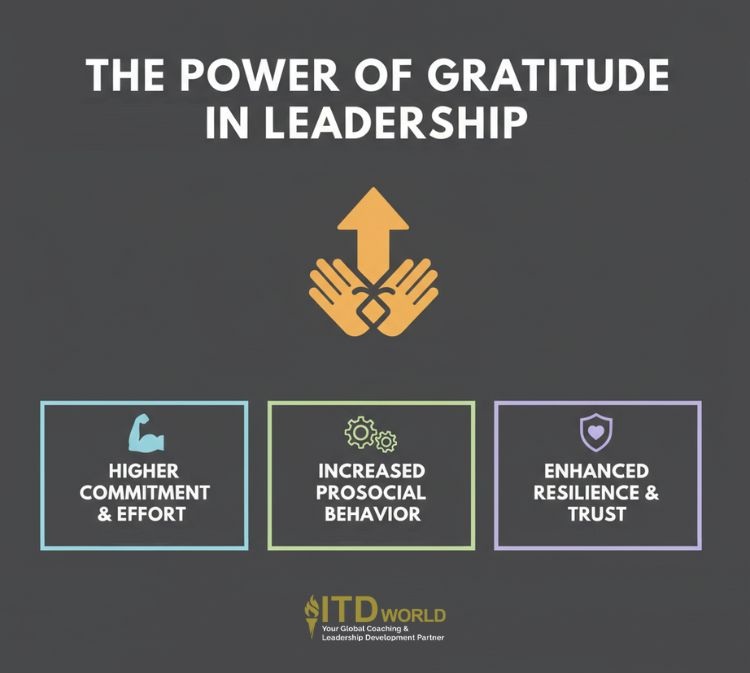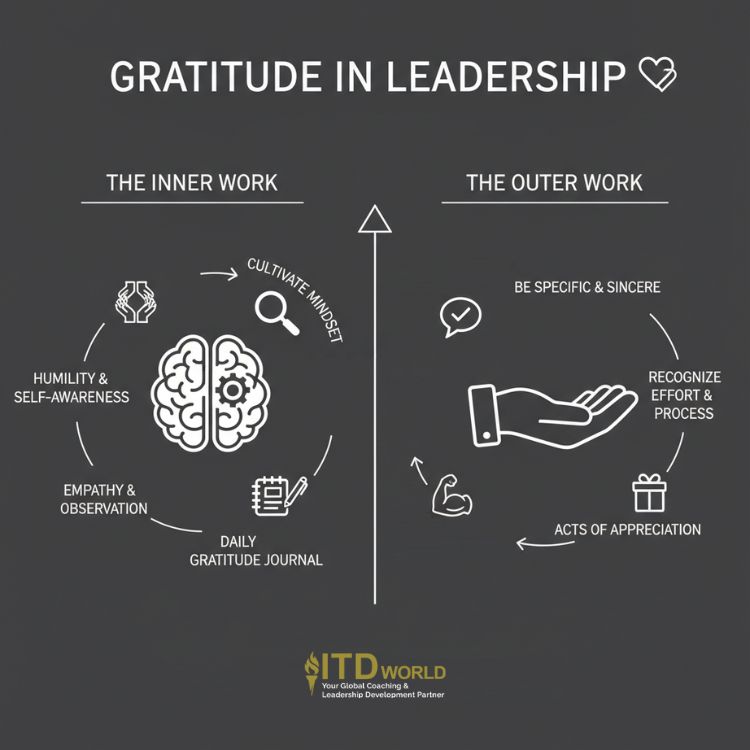Learn about the importance of gratitude in leadership, plus how to practice authentic appreciation in a way that boosts morale & performance.
We all know – intuitively and empirically – the value of showing appreciation as a leader. And yet, in many organizations, there exists a vast disconnect between managers who believe they express appreciation and employees who report feeling unseen and undervalued. More than a “soft” problem, this gap is a direct driver of disengagement, burnout, and costly employee turnover. Learning to truly practice gratitude in leadership is, therefore, a strategic antidote – a necessary practice to resolve these problems and ensure sustainable growth.
|
Author: Jonathan M. Pham |
Highlights
- Gratitude in leadership goes beyond passive thankfulness (“good job, everyone”); it is as the intentional act of recognizing the specific value and contribution of others in an authentic way (e.g., acknowledging a team member’s specific action that solved a critical bug).
- A lack of gratitude leads to employee disengagement and turnover. Conversely, an appreciative culture fosters higher commitment (employees work harder), increased prosocial behavior (more helpfulness and collaboration), and enhanced resilience and trust within teams.
- Effective leaders must first cultivate an internal mindset of humility, empathy, and observation (e.g., noticing effort, not just wins). They then need to express this through external actions that are specific, sincere, and demonstrate appreciation through concrete support like investing in growth or protecting well-being.
- The main obstacles to practicing gratitude in leadership are the fear of being inauthentic, the ego barrier (thinking employees are “just doing their job”), and the “busyness” barrier. Leaders can overcome these by focusing on factual specificity over forced emotion and by institutionalizing the habit of recognition.
What is Gratitude in Leadership?
In a leadership context, gratitude is far more than just good manners or a “soft” emotional state. It is an active and intentional practice of recognizing the value in others and acknowledging their contributions in a way that is authentic and meaningful.
To truly understand its power, we must first distinguish it from its more common relative: thankfulness. The philosopher Henri-Frédéric Amiel once captured this distinction perfectly as follows:
Thankfulness is the beginning of gratitude. Gratitude is the completion of thankfulness. Thankfulness may consist merely of words. Gratitude is shown in acts.
Thankfulness is, most of the time, an automatic and passive response. It’s the generic “thanks, everyone” at the end of a long team meeting or the “good job” sent in a group chat. While polite, these gestures lack specificity; hence, they often feel like a box-ticking exercise that has a very minimal impact on employee motivation.
Gratitude, on the other hand, is active, clear, and requires conscious effort. It is the act of truly seeing an individual’s contribution and making them feel valued for it.
Let us reflect on the following examples:
- Thankfulness (Words): A leader sends a team-wide email saying, “Thanks for all your hard work on the project launch.”
- Gratitude (Acts): A leader pulls a team member aside and says, “Sarah, I wanted to personally thank you for the work you did on the project launch. I know you stayed late on Tuesday to fix that critical bug. That specific action saved us from a major client issue, and I want you to know that your dedication did not go unnoticed.”
That second example is gratitude. It shows the leader was paying attention, and it connects the individual’s effort to a meaningful business impact. This is the practice that cultivates trust and loyalty, turning appreciation from a simple word into a powerful leadership act.

Gratitude meaning in leadership
The Importance of Gratitude in Leadership
⚠️The high cost of the “gratitude gap”
Failing to practice gratitude in leadership is not a neutral act; as mentioned, it creates a costly disconnect that can silently undermine the whole organization’s performance.
Studies show that more than 60% of employees believe they are undervalued at work. A lack of recognition is consistently cited as a top reason why people become disengaged, which costs companies billions in lost productivity, higher absenteeism, and increased errors. Those who do not feel appreciated are far more likely to experience burnout – and are the first to look for opportunities elsewhere, especially younger generations who prioritize meaningful work and consistent feedback.
🌟Benefits of an appreciative culture
Conversely, organizations that actively close this gap by fostering an appreciative culture see a powerful, measurable return on their investment. When leaders move from simple thankfulness to active gratitude, they unlock a host of benefits as follows:
- Higher commitment & discretionary effort
A Glassdoor survey found that 80% of employees say they would be willing to work harder for an appreciative boss. When leaders take the time to specifically and sincerely recognize effort, it validates the individual’s contribution and inspires them to give their best.
- Increased prosocial behavior
Gratitude doesn’t just make people feel good; it makes them act better. Research by Adam Grant, a leading organizational psychologist, found that when people are thanked for their efforts, they experience stronger feelings of self-efficacy and social worth. This, in turn, motivates them to be more helpful and collaborative with their colleagues, improving overall team dynamics.
- Enhanced resilience & trust
In challenging or uncertain times, a foundation of gratitude provides a reliable source of resilience. Teams that feel mutually appreciative are more likely to support one another, navigate conflicts constructively, and maintain a positive, solution-oriented mindset. It is one of the fastest and most effective ways to foster the psychological safety and trust essential for high-performing teams.
Read more: Gratitude in the Workplace – A Reflection on Its Miraculous Power

The power of gratitude in leadership
How to Practice Gratitude in Leadership
To close the “gratitude gap” and promote a high-appreciation culture, leaders must move beyond passive thankfulness to the active, intentional practice of gratitude. This is a learnable skill built on two distinct parts: the internal mindset you cultivate (the inner work) and the external behaviors you demonstrate (the outer work).
The foundation (the inner work)
You cannot express authentic gratitude if you do not first feel it or see the value in it. As such, you need to start by working on your personal mindset and core qualities.
Cultivate humility & self-awareness
Gratitude begins with knowing that your success is not achieved in a vacuum. It requires the self-awareness to see your own limitations – and the humility to understand that you are dependent on the skills, efforts, and support of your team. An arrogant leader who believes they are the sole source of success will never be able to show genuine appreciation.
Practice empathy & observation
A leader must cultivate the emotional intelligence to see the work through their team’s eyes. This means practicing empathy – not just for their feelings, but for the effort they expend. Additionally, it also requires you to be observant enough – to notice the employee who stays late to help a colleague, the quiet team member who provides the critical data, or the team that is struggling under a heavy workload.
Develop a personal habit of gratitude
A simple, yet amazingly effective practice is to start a daily gratitude journal. At the end of each workday, write down one specific contribution from a team member that you are thankful for and why it mattered. Over time, this will train your brain to actively look for the positive contributions of others.
Read more: Leadership Self-reflection – Looking Inward to Move Forward
The action (the outer work)
Once you are done with what lies within, you must express your attitude through clear, consistent, and meaningful acts.
Be specific & sincere
As mentioned, a generic, team-wide “good job, everyone” does no good at all. Real gratitude must links the person’s action to a positive outcome.
Ineffective thankfulness: “Thanks for your work on the report.”
Effective gratitude: “Alex, thank you for the detailed analysis you ran for that report. I know you had to pull data from three different systems to get it done, and that specific chart on slide 5 was what convinced the stakeholders to approve the new budget. Your thoroughness made a real difference.”
Recognize effort and process, not just wins
This is one of the most important – and often-missed leadership behaviors. If you only show appreciation when the team wins, you essentially breed a culture of fear in the process.
Example: If a team takes a smart, calculated risk on a new project that ultimately fails, a grateful leader will still praise their effort. “I want to recognize the incredible work the team did. Your innovative approach was exactly what we need, and we learned an invaluable lesson from this that will make our next attempt successful. Thank you for your courage.” Doing so is critical to fostering the inner strength and psychological safety needed for future innovation.
Show gratitude through what you do
Words are essential, but your actions are the ultimate proof of appreciation.
- Invest in their growth: “I’m so impressed with your problem-solving skills, I’ve approved you for that advanced certification course you wanted to take.”
- Grant them autonomy: “Your judgment on this has been excellent. I want you to take the full lead on the next phase of this project. I trust you to run with it.”
- Protect their well-being: “You’ve all been sprinting for a month and I am incredibly grateful for the effort. I’ve cleared the team’s calendars for this Friday afternoon for a ‘no-meetings’ recharge block. You’ve earned it.”
Read more: Human Centered Leadership – The Importance of a ‘People First’ Mindset

How to show gratitude as a leader
Challenges of Gratitude in Leadership
Knowing the “what” and “how” of gratitude in leadership is one thing; consistently practicing it, especially under pressure, is another. In fact, many leaders face internal barriers and misconceptions that make the practice feel difficult or unnatural at first.
- The “authenticity” trap
This is the common “it’s just not me” barrier. A leader might feel that expressing appreciation is awkward or that a simple “thank you” sounds hollow, like a script from a management seminar. This fear of being perceived as insincere often causes them to avoid it altogether.
Solution: Focus on specificity, not a grand performance. Authenticity doesn’t come from a forced, bubbly personality; it comes from sincerity and specificity. As we’ve discussed, a generic “good job” may come across as forced; on the other hand, a factual acknowledgment of a real effort is almost impossible to be perceived as fake.
Example: Instead of forcing yourself to be overly emotional, simply state the facts: “John, I want to acknowledge that I saw you stay late to help Sarah with her presentation. I know that wasn’t your project, and I appreciate your willingness to support the team.”
There is a common belief that “strong” leaders don’t need to be overly appreciative. The ego may get in the way, arguing that employees are just “doing their job” and don’t need special thanks for it. For some, they may even fear that showing gratitude will be seen as weakness or will undermine their authority.
Solution: Reframe gratitude as a tool of high standards. It demonstrates that you are confident enough in your own position to recognize and give credit to others. You are not thanking people for simply showing up; you are strategically reinforcing the high-quality behaviors you want to see repeated.
Example: When you thank someone for their “meticulous attention to detail on the budget,” you are not just being nice; you are publicly defining “attention to detail” as a core value and a standard of excellence for the entire team.
Read more: Ego in the Workplace – The Hidden ‘Evil’ Behind Team Dysfunctions
- The “busyness” barrier
Leaders are incredibly busy. When faced with urgent deadlines and a constant stream of “fire-fighting,” pausing to show appreciation is often the first “soft” task to be forgotten. Gratitude becomes a “nice to have,” not a “must do.”
Solution: Institutionalize the habit. You must treat it as a non-negotiable part of your leadership system, just like any other key performance indicator (KPI).
Example: Create a recurring private reminder in your calendar for 10 minutes every Friday afternoon with the simple task: “Send one specific ‘thank you’ email to a team member.” Or, make “Appreciation & Recognition” a standing 5-minute agenda item at the start of every weekly team meeting.

Leading with gratitude as a core value
Gratitude in Leadership Quotes
Check out more gratitude quotes here!
What we appreciate appreciates, and what we depreciate depreciates.
Gratitude is not only the greatest of virtues, but the parent of all the others.
Marcus Tullius Cicero
Feeling gratitude and not expressing it is like wrapping a present and not giving it.
William Arthur Ward
Gratitude makes sense of our past, brings peace for today, and creates a vision for tomorrow.
Melody Beattie
If you can’t reward, then you should thank.
Arabic Proverb
Gratitude puts you in a place where you’re humble.
Andra Day
The highest appreciation is not to utter words, but to live by them.
John F. Kennedy
Be grateful for little things every day and notice how your life changes as you marvel at bigger things that come your way.
Dr. Marshall Goldsmith & Dr. Peter Chee, ‘Mother of all Virtues‘
Leading with gratitude
Expressing gratitude as a leader
Gratitude in Leadership Books
- Leading with Gratitude by Adrian Gostick & Chester Elton
Eight actionable practices to help foster a culture of appreciation and boost employee engagement.
- Start With Why by Simon Sinek
While focused on purpose-driven leadership, Sinek also discusses gratitude as a key motivator for inspiring teams.
- The Greatness Guide by Robin Sharma
A collection of short, powerful lessons on leadership and personal growth, including the role of gratitude in success.
- Celebrations by Maya Angelou
A poetic tribute to everyday gratitude and joy, offering leaders a reflective lens on appreciation.
- Gratitude Works! by Robert A. Emmons
A science-based guide to cultivating gratitude, written by one of the world’s leading researchers on the topic.
- Thanks for the Feedback by Douglas Stone & Sheila Heen
Explores how leaders can receive and give feedback with grace and thankfulness to create stronger relationships.
Read more: Leadership Feedback – Key to Changing for the Better

How ITD World Can Help Build a Culture of Appreciation
Establishing an authentic culture of gratitude is a strategic leadership initiative. It requires leaders who possess the self-awareness to see the contributions of others, the humility to give credit, and the emotional intelligence to express appreciation in a way that is both sincere and impactful. These are not just personality traits; they are advanced leadership skills that can be systematically developed.
At ITD World, we specialize in helping individuals and organizations cultivate these essential human-centric competencies to build high-trust, high-performance cultures.
- Executive coaching: Our one-on-one coaching sessions provide a confidential space for participants to slowly move from a place of “ego” to one of “appreciation.”
- Leadership workshops: We offer targeted programs on Emotional Intelligence and Giving Effective Recognition (as a core part of feedback). These workshops equip participants with the practical tools to understand their team’s motivations and to deliver appreciation that drives performance.
- Customized in-house programs: We partner with organizations to design and implement comprehensive solutions that foster a culture of appreciation. This can include aligning your recognition programs, training your entire management team, and fostering a system where gratitude becomes a daily, lived value.
Ready to close the gratitude gap and unleash the full potential of your team? Contact ITD World today to learn how our solutions can help!
Other resources you might be interested in:
- Resilient Leadership: The Reliable Compass Through Uncertainty
- Spiritual Leadership: A Remedy for Today’s Workplace Woes
- Love Leadership: More Than an Abstract Philosophical Idea
- Agility Coaching: Navigating Change & Fueling Business Success
- Coaching Culture: Building a Blueprint for Organizational Growth

